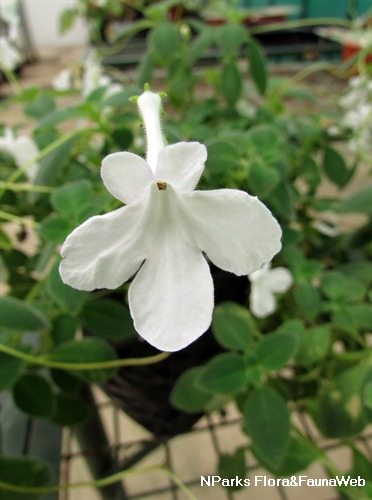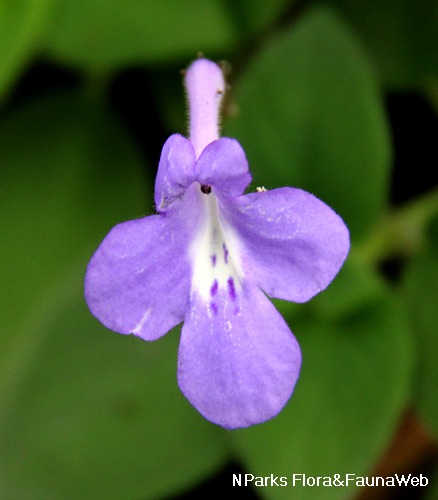
Back
Streptocarpus ionanthus (H.Wendl.) Christenh.
| Family Name: | Gesneriaceae |
| Synonyms: | Saintpaulia ionantha H.Wendl. |
| Common Name: | African Violet, 非洲堇, 非洲紫罗兰 |
Streptocarpus ionanthus or African violet is a low, compact plant with dark green, thick, hairy leaves. Flowers are tubular, purple or white in colour. African violet is widely cultivated into numerous cultivars and hybrids. They can come in various shades of pink, fuschia or variegated.
Name
Classifications and Characteristics
| Plant Division | Angiosperms (Flowering Seed Plants) |
|---|---|
| Plant Growth Form | Herbaceous Plant |
| Lifespan (in Singapore) | Perennial |
Biogeography
| Native Distribution | Africa |
|---|---|
| Native Habitat | Terrestrial |
Description and Ethnobotany
| Growth Form | It is a herbaceous plant with a low, compact growth form. |
|---|---|
| Foliage | Its succulent leaves are round to oval, dark-green, covered with whitish hairs. |
| Flowers | Flowers are short, tubular, violet-blue or white in colour. |
| Cultivation | African violets need porous soils with good drainage, under partial shade or bright filtered sunlight. |
Landscaping Features
| Desirable Plant Features | Ornamental Flowers |
|---|---|
| Landscape Uses | Interiorscape/ Indoor Plant |
Plant Care and Propagation
| Light Preference | Semi-Shade |
|---|---|
| Water Preference | Moderate Water |
| Plant Growth Rate | Moderate |
| Rootzone Tolerance | Well-Drained Soils |
| Propagation Method | Seed, Tissue Culture |
| Propagation Method Remarks | Leaf cutting |
Foliar
| Mature Foliage Colour(s) | Green |
|---|---|
| Leaf Area Index (LAI) for Green Plot Ratio | 4.5 (Shrub & Groundcover - Dicot) |
Floral (Angiosperm)
| Flower Colour(s) | Red, Pink, Purple, White |
|---|---|
| Flower Grouping | Cluster / Inflorescence |
Image Repository
Others
| Master ID | 1119 |
|---|---|
| Species ID | 2412 |
| Flora Disclaimer | The information in this website has been compiled from reliable sources, such as reference works on medicinal plants. It is not a substitute for medical advice or treatment and NParks does not purport to provide any medical advice. Readers should always consult his/her physician before using or consuming a plant for medicinal purposes. |





